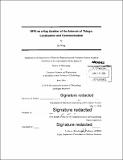| dc.contributor.advisor | Dina Katabi. | en_US |
| dc.contributor.author | Wang, Jue, 1986- | en_US |
| dc.contributor.other | Massachusetts Institute of Technology. Department of Electrical Engineering and Computer Science. | en_US |
| dc.date.accessioned | 2014-09-19T21:33:56Z | |
| dc.date.available | 2014-09-19T21:33:56Z | |
| dc.date.copyright | 2014 | en_US |
| dc.date.issued | 2014 | en_US |
| dc.identifier.uri | http://hdl.handle.net/1721.1/90005 | |
| dc.description | Thesis: Ph. D., Massachusetts Institute of Technology, Department of Electrical Engineering and Computer Science, 2014. | en_US |
| dc.description | Cataloged from PDF version of thesis. | en_US |
| dc.description | Includes bibliographical references (pages 157-167). | en_US |
| dc.description.abstract | By having everything in our physical world digitally connected, the Internet of Things is expected to transform how we interact with our environments and unlock tremendous business values through advance analytics. Owing to its low cost, small form factor, and its ability to communicate without a battery, RFID has emerged as a key enabler for digitally connecting, identifying, and tracking everyday objects. Each year, billions of RFIDs are being deployed to tag retail goods, track pharmaceuticals, and build smart infrastructures. However, core technical challenges in localization and data communication remain to be addressed, before RFID could reach its full potential in the Internet of Things. Today's RFID systems can only identify whether a tagged object is within radio range (up to tens of meters) while lacking the capability to pinpoint its exact location. This dissertation presents three centimeter-scale RFID localization designs, each introducing a set of new techniques and targeting a different application: 1) business analytics and asset management; 2) navigating a robot toward an RFID-tagged object and estimating its position and orientation for manipulation; 3) a virtual touch screen enabled by tracing the detailed trajectory of the RFID on an user's finger to reconstruct her drawing or handwriting in the air. Beyond locating and tracking objects, RFID also holds great potential in forming ultra-low power sensor networks to collect data. A major problem that has challenged this vision is that, unlike WiFi or cellular devices, backscatter RFIDs lack functionalities like carrier sense and rate adaptation, and hence RFID-sensor networks tend to suffer from collisions and inefficient data communication. In this dissertation, instead of considering collision as detrimental and trying to avoid it, we show how to transform collisions into a distributed code across the bits transmitted by a network of RFIDs. We leverage this collision-based code to achieve fast node identification and automatic rate adaptation, improving RFID network reliability and efficiency. | en_US |
| dc.description.statementofresponsibility | by Jue Wang. | en_US |
| dc.format.extent | 167 pages | en_US |
| dc.language.iso | eng | en_US |
| dc.publisher | Massachusetts Institute of Technology | en_US |
| dc.rights | M.I.T. theses are protected by copyright. They may be viewed from this source for any purpose, but reproduction or distribution in any format is prohibited without written permission. See provided URL for inquiries about permission. | en_US |
| dc.rights.uri | http://dspace.mit.edu/handle/1721.1/7582 | en_US |
| dc.subject | Electrical Engineering and Computer Science. | en_US |
| dc.title | RFID as a key enabler of the internet of things : localization and communication | en_US |
| dc.title.alternative | Radio-frequency identification as a key enabler of the internet of things | en_US |
| dc.type | Thesis | en_US |
| dc.description.degree | Ph. D. | en_US |
| dc.contributor.department | Massachusetts Institute of Technology. Department of Electrical Engineering and Computer Science | |
| dc.identifier.oclc | 890133296 | en_US |
